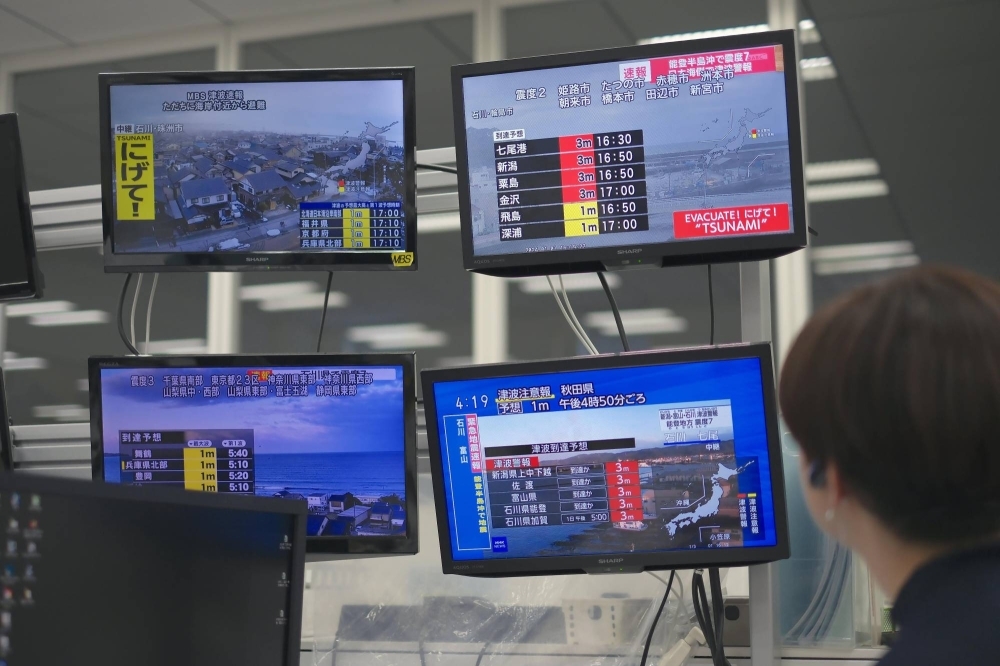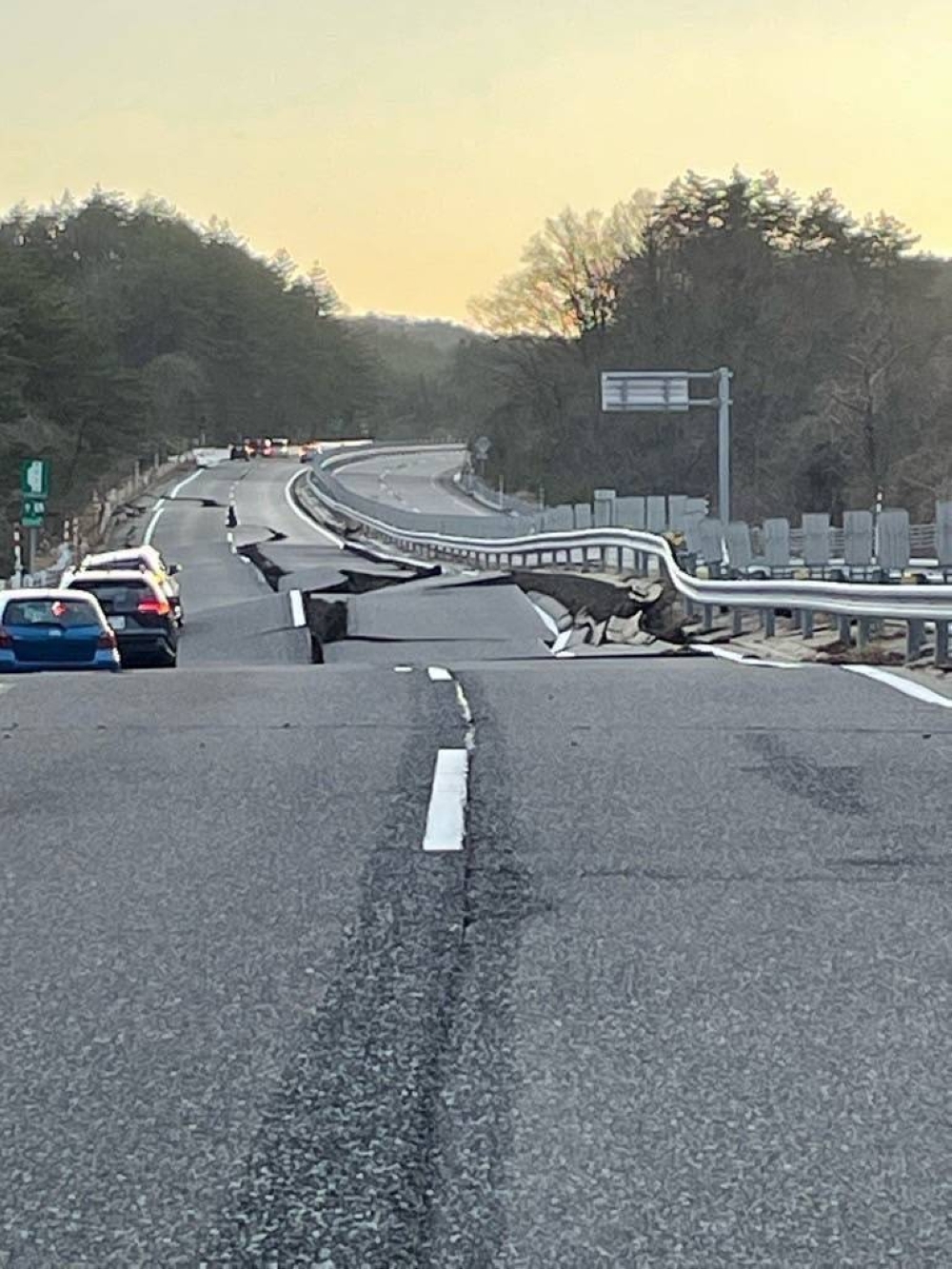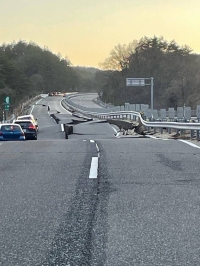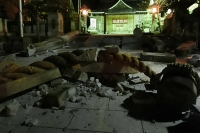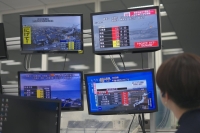Japan was rocked Monday by a powerful earthquake measuring a 7 on Japan’s shindo scale — the strongest rating — prompting tsunami warnings for the length of the country's western coast and inflicting widespread damage.
Tsunami waves were recorded in some areas following the magnitude 7.6 quake, which struck near Ishikawa Prefecture’s Noto Peninsula at around 4:10 p.m. It was followed by several strong aftershocks.
At least five people have died while others were trapped in collapsed buildings. A large-scale fire also broke out in in Wajima, Ishikawa Prefecture, following the quake, while several other municipalities reported collapsed houses.
Several injuries were reported, including two women who were taken to hospitals after falling or being hit by falling objects in Awara, Fukui Prefecture, local authorities said. A woman in her 80s in Itoigawa, Niigata Prefecture, fell while evacuating and suffered a head injury.
In Ishikawa, approximately 32,500 homes lost power.
A total of more than 51,000 people in five prefectures were instructed to evacuate, according to the Fire and Disaster Management Agency.
About 1,000 residents and others evacuated to an Air Self-Defense Force base in Wajima, and the SDF is responding by distributing blankets, water and food, the Defense Ministry said.
Ishikawa Gov. Hiroshi Hase asked the SDF to send members on a disaster relief mission, according to the central government.
The quake's epicenter was in the Noto region, which is prone to major earthquakes. Its depth was very shallow, according to the weather agency.
No abnormalities were reported at nuclear plants in the country after the earthquake, the government said.
East Japan Railway Co. temporarily suspended operations of all Tohoku, Joetsu and Hokuriku Shinkansen lines due to the earthquake.
A major tsunami warning — the highest level of alert — had been issued for Ishikawa Prefecture’s Noto Peninsula, with the weather agency warning of waves of up to 5 meters in the area. This was later downgraded, but the entire Sea of Japan coast remained under tsunami warnings or advisories, with waves of up 3 meters possible.
A major tsunami warning had not been issued since the March 2011 Great East Japan Earthquake, the Meteorological Agency said.
Waves of over 1 meter are considered likely to make it difficult for people to stand, and such tsunami can be deadly, according to the weather agency.
The tsunami warning for Ishikawa, Niigata, Toyama and Yamagata prefectures urged people to quickly leave coastal areas, with over 1.2 meter waves reaching the Noto Peninsula’s Wajima Port in Ishikawa at around 4:21 p.m., the weather agency said. NHK cautioned that waves may have been higher than this depending on the exact location.
The agency said areas that experienced strong shaking could see quakes of up to shindo 7 over the next week, especially in the next two to three days.
Speaking to reporters in the evening, Prime Minister Fumio Kishida urged residents of the affected areas to “continue to pay close attention in case of strong earthquakes.”
“And in areas where tsunamis are expected, I would like to request that they evacuate as soon as possible,” he said in Tokyo.
The tsunami warnings were punctuated by several aftershocks across the Noto Peninsula following the largest initial quake, recorded as magnitude 7.6, according to the Meteorological Agency.
As of 5:30 p.m., agency data indicated that tremors measuring shindo 1 or higher occurred 19 times on Monday including shindo 7 main shock and five measuring strong 5.
Waves of 80 cm reached Toyama Prefecture at around 4:35 p.m and waves of 40 centimeters also reached the city of Kashiwazaki, in Niigata Prefecture, at 4:36 p.m. Kanazawa Port in Ishikawa experienced 40 cm waves at around 5:04 p.m., while waves were also reported in Yamagata Prefecture and Niigata’s Sado Island.
Chief Cabinet Secretary Yoshimasa Hayashi told reporters at a news conference that no abnormalities had so far been reported from nuclear power plants across Japan. “We are still assessing human and physical damage,” he said.
The quake was also felt in Tokyo and across the Kanto area.
Jordan Allen, a news editor at The Japan Times who is normally based in Tokyo, was in eastern Toyama Prefecture when the earthquake struck, spending New Year’s day with family. After the first big earthquake hit, he remained seated in the living room gauging the situation for a moment before a second quake struck, with phone tsunami warnings and area alarms kicking in right after.
“I've lived in Japan for nine years and I've not felt anything like this before,” he said, adding that some drinking glasses and other items had fallen and broken around the home. He said he had not been able to confirm any serious damage in his immediate vicinity. He added that he had heard unconfirmed reports of traffic congestion in the city of Namerikawa, in Toyama Prefecture, as residents attempted to drive to higher ground in mountainous areas.
The magnitude of Monday’s quake matches that of the 1983 Sea of Japan earthquake, in which 104 people died and 324 were injured.
The Russian government issued a tsunami warning for the western coastal region of Sakhalin in the Far East following the earthquake, the Interfax news agency said.
North and South Korea both issued similar alerts for their eastern coastal areas, according to local media and authorities.
More information:
- Detailed information about the latest earthquakes, from the Japan Meteorological Agency website
- An explanation of shindo, Japan's earthquake intensity scale
- A guide to what to before, during and after an earthquake
- Our portal for disaster-related information




